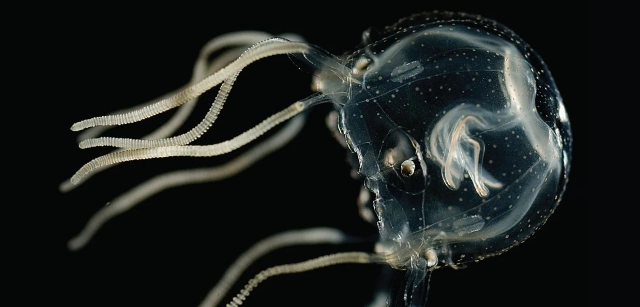They trained Caribbean jellyfish to learn how to detect and avoid obstacles. The study challenges the idea that advanced learning requires a central brain and sheds light on the evolutionary roots of learning and memory
People’s Army
Monday, September 25, 2023
Jellyfish can learn from past experiences like humans, mice and flies, even without a central brain, scientists first report in the journal Current biology (1).
Jellyfish can learn from past experiences like humans, mice and flies, even without a central brain
They trained com. boxjellyfish from the Caribbean (Tripidalia cestophora) So they learn to spot and avoid obstacles. The study challenges the idea that advanced learning requires a central brain and sheds light on the evolutionary roots of learning and memory.
This seemingly simple jellyfish, about the size of a fingernail, has a complex visual system with 24 eyes embedded in its bell-like body. They live in mangroves and use their vision to navigate through turbid water and avoid tree roots to catch their prey.
Avoid obstacles through associative learning
Scientists have demonstrated that jellyfish can acquire the ability to avoid obstacles through associative learning, a process by which organisms form mental associations between sensory stimuli and behaviors.
“Learning is the maximum performance of the nervous system — Says first author, Jan Bielecki, from Kiel University (Germany). To successfully teach a jellyfish a new trick, he says, “it’s best to take advantage of its natural behaviors, which is what makes sense for the animal, until it reaches its full potential.”
The team dressed the tank in a round tank with gray and white stripes to mimic the jellyfish’s natural habitat, with the gray stripes mimicking the roots of mangrove trees that may be visible in the distance. They watched the jellyfish in the tank for 7.5 minutes.
At first, the jellyfish swam close to these seemingly distant rays, repeatedly bumping into them.
But at the end of the experiment, the jellyfish increased its average distance to the wall by about 50%, quadrupled the number of successful turns to avoid collision, and reduced its contact with the wall by half.
At first, the jellyfish swam close to these seemingly distant rays, repeatedly bumping into them. But at the end of the experiment, the jellyfish increased its average distance to the wall by about 50%, quadrupled the number of successful turns to avoid collision, and reduced its contact with the wall by half. The results suggest that jellyfish can learn from experience through visual and mechanical stimuli.
“If you want to understand complex structures, it’s always a good idea to start as simple as possible. –Comments Anders Jarm, lead author of the study and professor at the University of Copenhagen (Denmark)–. “By looking at these relatively simple jellyfish nervous systems, we have a much better chance of understanding all the details and how they come together to perform behaviors.”
Next, the researchers attempted to determine the basic process of associative learning in jellyfish by isolation They are called visual sensory centers in animals rhopalia. Each of these structures includes six eyes It generates pacemaker signals that control the jellyfish’s pulsating movement, which increases in frequency as the animal veers away from obstacles.
A combination of visual and mechanical stimuli
Show the team rhopalium Static gray bars move to mimic an animal approaching objects. The structure did not respond to the light gray bars, interpreting them as being far away. However, after the researchers trained rhopalia With weak electrical stimulation as the bars approached, it began to generate obstacle avoidance signals in response to the light gray bars.
These electrical stimuli mimic the mechanical stimuli of a collision. The results also showed that the combination of visual and mechanical stimuli is necessary for associative learning in jellyfish rhopalium Serves as a learning center.
Team plans Delve into the cellular interactions of the jellyfish’s nervous system to uncover memory formation. They also plan to better understand how the mechanical timbre sensor works to get a complete picture of the animal’s associative learning.
“It’s amazing how quickly these animals learn; at about the same rate as advanced animals,” Garm says. “Even the simplest nervous system seems capable of advanced learning, and this can be transformed into a cellular mechanism.” “It was invented at the dawn of the development of the nervous system.”

“Beer enthusiast. Subtly charming alcohol junkie. Wannabe internet buff. Typical pop culture lover.”

:quality(85)/cloudfront-us-east-1.images.arcpublishing.com/infobae/BSBBGIRD3RGW3IFZ7323CC76AA.jpg)





More Stories
Leica returns to mobile photography in Latin America with the help of Xiaomi with the Xiaomi 14 Ultra
xQc finds out how much money has been spent on his Steam account. “I thought it would be much less.”
Scientist who studied coronavirus claims it was part of a computer simulation: 'It was programmed'